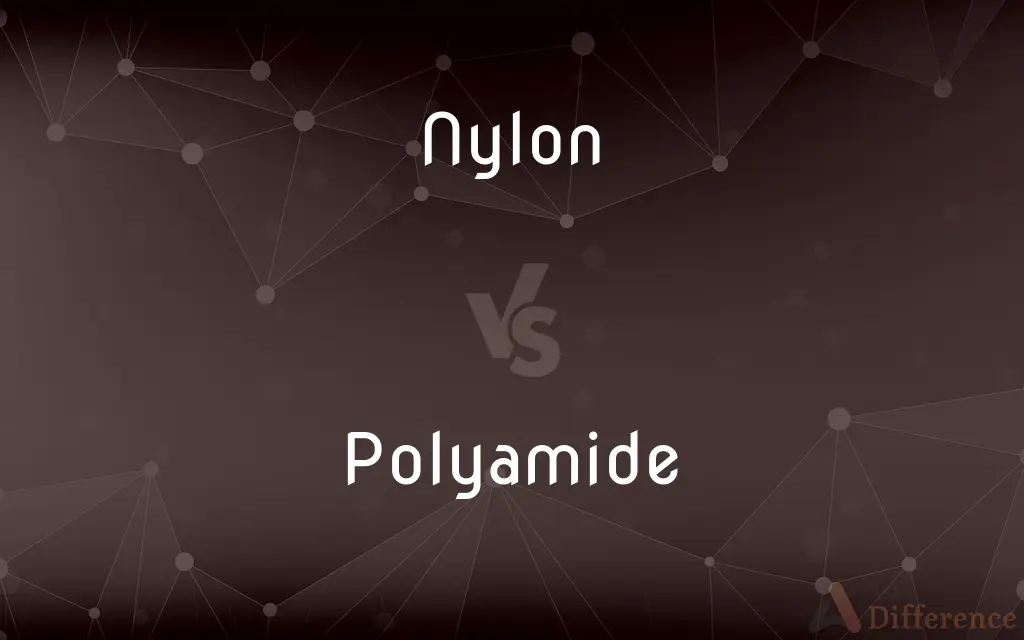Nylon vs. Polyamide — What's the Difference?
By Tayyaba Rehman — Updated on April 4, 2024
Nylon is a type of synthetic polymer, specifically a polyamide, whereas Polyamide is a macromolecule with repeating units linked by amide bonds.

Difference Between Nylon and Polyamide
Table of Contents
ADVERTISEMENT
Key Differences
Nylon and Polyamide are terms that can often be used interchangeably, particularly in the textile industry. However, while Nylon is a specific type of polyamide, not all polyamides are nylon. It's the distinction between a brand and a generic term.
Nylon was the first synthetic fiber to be commercially produced, and it garnered significant attention due to its strength and elasticity. Polyamide, on the other hand, encompasses a broader category of synthetic polymers, of which nylon is a member.
In terms of chemical composition, nylon is always a polyamide, but not every polyamide is nylon. For instance, while Nylon 6 or Nylon 6,6 are specific types of polyamides, there are other polyamides which don't fall under the nylon category.
Durability, moisture absorption, and elasticity are some characteristics associated with nylon. Polyamide, being a broader category, can exhibit a range of properties, though they all have the amide bond in common.
When shopping for clothing or textiles, consumers might notice labels with "nylon", signifying the use of this specific polyamide. In contrast, polyamide might be used as a term when discussing the broader category of polymers in a scientific or technical setting.
ADVERTISEMENT
Comparison Chart
Definition
A specific type of synthetic polymer
A macromolecule with repeating amide bonds
Scope
A subtype of polyamides
Broad category including many polymers
Examples
Nylon 6, Nylon 6,6
Nylon, Kevlar, etc
Primary Use
Textiles, brushes, parachutes
Various based on specific polyamide type
Origins
Commercially produced synthetic fiber
Describes any polymer with amide bonds
Compare with Definitions
Nylon
A synthetic fabric material.
She wore a nylon jacket.
Polyamide
A chemical structure present in proteins.
Proteins have polyamide bonds, similar to synthetic polymers.
Nylon
A specific type of polyamide.
The rope is made of nylon.
Polyamide
A category including many synthetic fibers.
Kevlar is a well-known polyamide.
Nylon
A material used in stockings.
She opted for nylon stockings due to their smooth feel.
Polyamide
A polymer containing amide bonds.
The plastic is a type of polyamide.
Nylon
Resistant to moisture and chemicals.
Use nylon gloves for this task.
Polyamide
Materials known for strength and elasticity.
Polyamides are often used in active wear.
Nylon
Nylon is a generic designation for a family of synthetic polymers composed of polyamides (repeating units linked by amide links). Nylon is a silk-like thermoplastic, generally made from petroleum, that can be melt-processed into fibers, films, or shapes.
Polyamide
Any polymer of a type including nylons.
Several polyamides are used in textile manufacturing.
Nylon
Any of a family of high-strength, resilient synthetic polymers, the molecules of which contain the recurring amide group CONH.
Polyamide
A polyamide is a polymer with repeating units linked by amide bonds.Polyamides occur both naturally and artificially. Examples of naturally occurring polyamides are proteins, such as wool and silk.
Nylon
Cloth or yarn made from one of these synthetic materials.
Polyamide
A synthetic polymer of a type made by the linkage of an amino group of one molecule and a carboxylic acid group of another, including many synthetic fibres such as nylon.
Nylon
Nylons Stockings made of one of these synthetic materials.
Polyamide
A polymer containing repeated amide groups, as in various kinds of nylon.
Nylon
Originally, the DuPont company trade name for polyamide, a copolymer whose molecules consist of alternating diamine and dicarboxylic acid monomers bonded together; now generically used for this type of polymer.
Polyamide
(chemistry) Any of a range of polymers containing amide (or peptide) repeat units; examples include proteins and nylon.
Nylon
(in the plural) A stocking originally fabricated from nylon; also used generically for any long, sheer stocking worn on a woman's legs.
I tore a hole in my nylons while walking home through the woods.
Polyamide
A polymer containing repeated amide groups
Nylon
(perjoratively, by comparison to silk) A Queen's Counsel, King's Counsel or Senior Counsel who was appointed as a courtesy, rather than on merit.
Nylon
Any of several thermoplastic polyamide plastics, comprising a family of high-strength resilient synthetic materials, used mostly in fibers.
Nylon
A synthetic fabric consisting of fibers of nylon[wn1].
Nylon
Stockings made of a thin form of nylon{2}, especially full-length stockings either sheer of of varying shades.
Nylon
A thermoplastic polyamide; a family of high-strength resilient synthetic materials
Nylon
A synthetic fabric
Nylon
A thermoplastic silky material.
The toothbrush bristles are made of nylon.
Common Curiosities
Was nylon the first synthetic fiber?
Yes, nylon was the first commercially produced synthetic fiber.
Is Kevlar a type of nylon?
No, Kevlar is a type of polyamide, but it's not categorized as nylon.
Are nylon and polyamide resistant to heat?
They have moderate heat resistance but can melt under high temperatures.
Is nylon biodegradable?
Traditional nylon isn't readily biodegradable, but there are bio-nylons now available.
Is nylon the same as polyamide?
Nylon is a type of polyamide, but not all polyamides are nylon.
Do all polyamides have the same properties?
No, different polyamides have varied properties, but all contain amide bonds.
Why is nylon used in clothing?
Due to its strength, elasticity, and resistance to moisture.
Does the term "polyamide" refer only to synthetic polymers?
No, it refers to any polymer with amide bonds, including those in nature like proteins.
How do the properties of nylon compare to natural fibers?
Nylon typically has greater strength, elasticity, and moisture resistance than many natural fibers.
Why are polyamides used in plastics?
Polyamides have a good balance of strength, flexibility, and chemical resistance.
Do polyamides absorb water?
Polyamides can absorb moisture but to varying degrees based on their type.
Are all nylons made from petroleum?
Most traditional nylons are derived from petroleum, but bio-based alternatives are emerging.
Can nylon be recycled?
Yes, nylon can be recycled, though the process is specific.
Are polyamide materials used in safety equipment?
Yes, some polyamides like Kevlar are used in bulletproof vests due to their strength.
Are nylons used outside the textile industry?
Yes, nylons are used in various products like ropes, brushes, and car parts.
Share Your Discovery

Previous Comparison
Prey vs. Pray
Next Comparison
Algorism vs. AlgorithmAuthor Spotlight
Written by
Tayyaba RehmanTayyaba Rehman is a distinguished writer, currently serving as a primary contributor to askdifference.com. As a researcher in semantics and etymology, Tayyaba's passion for the complexity of languages and their distinctions has found a perfect home on the platform. Tayyaba delves into the intricacies of language, distinguishing between commonly confused words and phrases, thereby providing clarity for readers worldwide.
















































